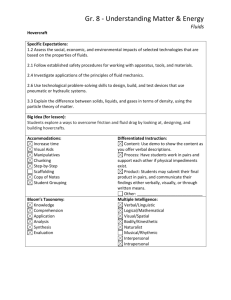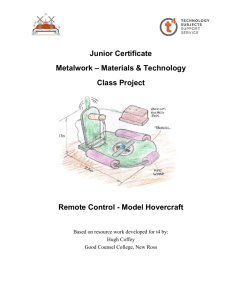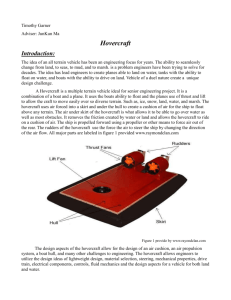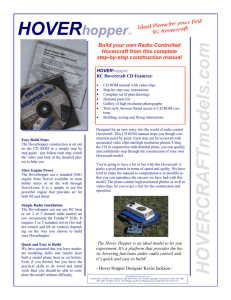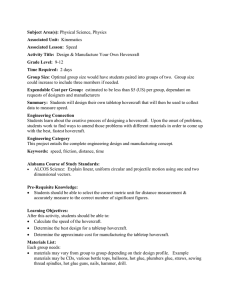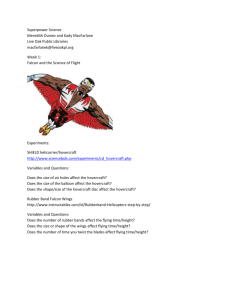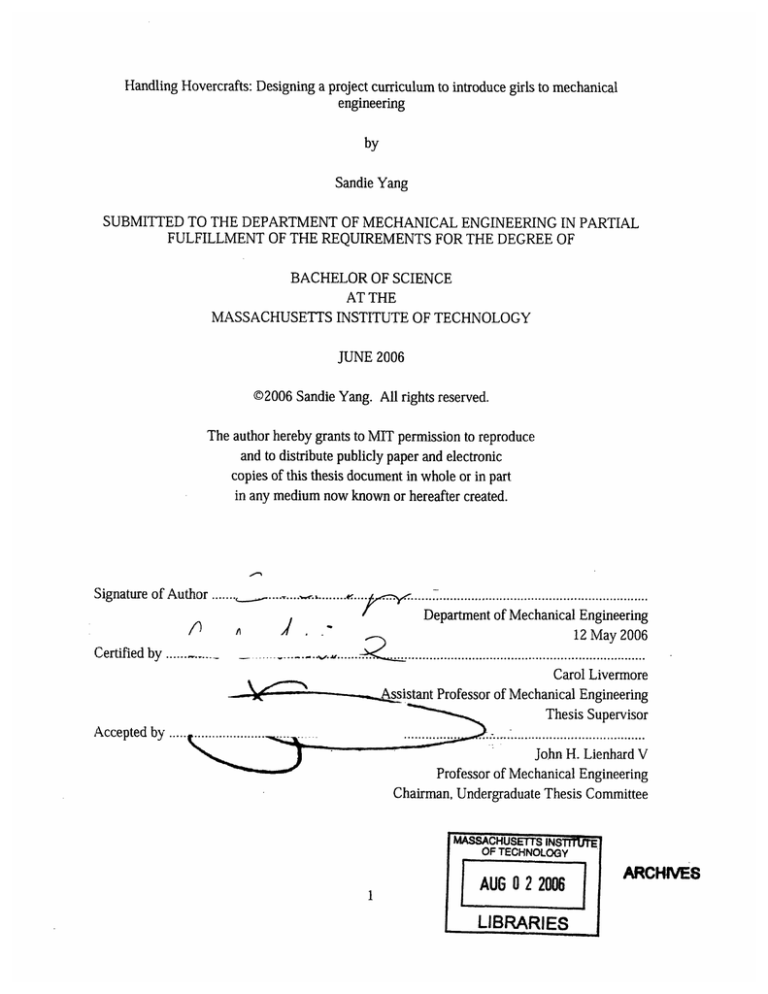
Handling Hovercrafts: Designing a project curriculum to introduce girls to mechanical
engineering
by
Sandie Yang
SUBMITTED TO THE DEPARTMENT OF MECHANICAL ENGINEERING IN PARTIAL
FULFILLMENT OF THE REQUIREMENTS FOR THE DEGREE OF
BACHELOR OF SCIENCE
AT THE
MASSACHUSETTS INSTITUTE OF TECHNOLOGY
JUNE 2006
©2006 Sandie Yang. All rights reserved.
The author hereby grants to MIT permission to reproduce
and to distribute publicly paper and electronic
copies of this thesis document in whole or in part
in any medium now known or hereafter created.
Signature of Author
. ......
..........
/...
/'3
A
Certifiedby
J
......
.
-
,. ..........
~/ Department of Mechanical Engineering
12 May 2006
.00..
. .....................................................................
.....
Carol Livermore
Assistant Professor of Mechanical Engineering
Thesis Supervisor
Accepted by ......................... .A.
..
.
.
.
.
John H. Lienhard V
Professor of Mechanical Engineering
Chairman, Undergraduate Thesis Committee
OF TECHNOLOGY
ARCHIVES
AUG 0 2 2006
1
I.
I
LIBRARIES
Handling Hovercrafts: Designing a project curriculum to introduce girls to mechanical
engineering
by
Sandie Yang
Submitted to the Department of Mechanical Engineering
on May 12, 2006 in partial fulfillment of the
requirements for the Degree of Bachelor of Science in
Mechanical Engineering
Abstract
The Women's Technology Program was created in MIT's Electrical Engineering and
Computer Science department to expose girls to engineering topics and to encourage them to
choose engineering majors in college. For the upcoming launch of a WTP in the mechanical
engineering department, a new curriculum is being developed. The objective of this research
was to create a capstone design project for the WTP-ME curriculum that sparks high school
girls' interest in design and manufacturing. A hovercraft design contest was chosen as the basis
for the project because of the range of concepts it encompasses and because the competitive
nature of the project would encourage cooperation and motivation among the students. To test
the project's feasibility, several hovercrafts were built using different materials and geometries.
A list of materials was created and contest rules were constructed based on the results, and one
hovercraft design was selected to be used as a template hovercraft for the students.
Thesis Supervisor: Carol Livermore
Title: Assistant Professor of Mechanical Engineering
.?
2
**
...
Table of Contents
ABSTRACT----------------------------------
---------------------------------------------------2
TABLE OF CONTENTS--------------------------------3
INTRODUCTION TO THE WOMEN'S TECHNOLOGY PROGRAM-----------------------------------------------4
WOMEN'S TECHNOLOGY PROGRAM - ME----------------------------------------------------------------------------4
PURPOSE----------------------------------------------------------------------------------------------------------------------------5
PROJECT----------------------------------------------------------------------------------------------------------------------------5
CONSIDERATIONS ----------------------------------------------------------------------------STUDENT BACKGROUND ---------------------------------------------------------
6
------------------------------------- 7
PROJECT FIT WITHIN WTP-ME------------------------------------------------------------------------------------------
7
FAIR CONTEST----------------------------------------------------------------------------------------8
FEASIBILITY----------------------------
----------------------- 9
BUILDING HOVERCRAFTS--------------------------------------------------------------------------------------------------10
HOVERCRAFT
THEORY------------------------------------------------------------------------------------------------------13
PROJECT CURRICULUM: HOVERCRAFT CONTEST KIT---------------------------------------------------------15
CONCLUSIONS-------------------------------
---------------------------------------------16
ACKNOWLEDGMENTS--------------------------------------------------------13
REFERENCES-----------------------------------
--------------------------------------------13
APPENDIX A-----------------------------------------------------------------------------------------------------------------------18
APPENDIX B-----------------------------------------------------------------------------------------------------------------------20
APPENDIX C-----------------------------------------------------------------------------------------------------------------------21
3
Introduction to the Women's Technology Program
In 2002, a residential summer program called the Women's Technology Program (WTP)
was created at MIT for high school girls. Its purpose was to encourage women to enter the fields
of electrical engineering and computer science by sparking their interest with an engaging
curriculum and a supportive environment.
WTP consists of four weeks of classes in electrical engineering, computer science, and
mathematics. Curriculum is structured around laboratory projects that emphasize learning by
doing and collaborative problem solving. Projects are designed with high school girls in mind,
and all classes are taught by female graduate students.
Admission to WTP is competitive. In 2005, 408 girls applied and 40 were accepted. The
program also seems to be effective: of the women who participated in WTP 2005, 37 applied to
MIT in the fall. This high application rate indicates that the program may be succeeding in
encouraging these girls to seriously consider careers in engineering.
Women's Technology Program - ME
WTP has been highly successful in its first four years of development.
It has been so
successful, in fact, that a pilot Women's Technology Program is being developed in the
Mechanical Engineering department for the summer of 2006.
The goal of WTP-ME is to encourage women to become engineers by promoting the
development of their self-confidence and their interest in mechanical engineering.
The
curriculum will be designed to introduce girls to different mechanical engineering topics,
including mechanics and materials, dynamics, fluids, and design and manufacturing, along with
the math they will need to grasp the material. Guest speakers, mostly faculty members from the
4
mechanical engineering department, will give presentations on current research at MIT. The
classes will culminate in a capstone design project that encourages hands-on building and
collaboration.
WTP-ME will operate on a small scale, admitting 20 students every year rather than the
original WTP's 40.
The goal is for WTP to eventually expand into other engineering
departments at MIT.
Purpose
The purpose of this thesis is to create a capstone project for WTP-ME. Several factors must
be taken into account. First, the project must be challenging but workable for 1 1th-gradegirls,
students who are academically gifted but who also come from a variety of academic
backgrounds.
Second, since the project will be part of an introduction to mechanical
engineering, it will ideally incorporate multiple engineering concepts such as design and
manufacturing, solid mechanics, and fluid dynamics. Finally, the project needs to be flexible and
interesting enough to encourage creativity and collaboration among the students.
Project
The capstone project for WTP-ME is meant to be a hands-on introduction to design and
manufacturing that begins during the third week of the four-week program. At this point, the
students will have had brief, 90-minute lessons on broad topics such as solid materials, fluids,
and thermodynamics and heat transfer. It is important that the project not require too much
knowledge of these concepts, but it should give them a chance to apply what they have learned to
a real design problem.
5
For the first WTP-ME program, a hovercraft design competition has been selected as the
basis for the capstone project. A few factors were involved in making this decision. First,
hovercraft design can easily incorporate concepts such as solid mechanics and fluid flow, so the
students will be able to see how theoretical models relate to real-life problem solving.
Hovercrafts were also chosen over more common project ideas, such as cars, because there is
less of a stigma against hovercraft-building as a male-dominated activity. A contest could be an
effective way to produce excitement and self-motivation among the students, and if the project is
team-based, it would encourage collaboration and allow the students to take advantage of their
diverse backgrounds by sharing ideas with each other.
Hovercrafts have been used to introduce students to engineering before. Southern Illinois
University (SIU), for example, used kits developed by Universal Hovercraft to teach design in
their Women in Engineering Summer Program.'
Students there assembled hovercrafts from
identical kits and then raced their vehicles against each other. The main difference between the
WTP-ME hovercraft project and the SIU program lies in the amount of student involvement in
the design of their machines. Not only will WTP-ME students have infinitely more flexibility by
building their machine from raw materials, they will be able to account for their decisions using
the physics and engineering concepts they have learned over the course of the program.
Considerations
There are several specific design considerations when it comes to creating a project for
students.
Student backgrounds, the project's fit within the curriculum, contest logistics, and
design feasibility are issues that must be taken into account.
6
Student Background
Students are admitted into WTP and WTP-ME based on a complex selection process that
emphasizes academic excellence and subjective criteria such as eagerness to learn, willingness to
work with others, and creativity.
The girls will be coming from a wide range of public and private high schools from around
the country, but their academic backgrounds are consistently strong. For example, the average
math PSAT score of the twenty students admitted to WTP-ME this year is 74 out of 80. Most of
these students have taken at least basic biology, chemistry, and physics, and some have taken one
or more of these subjects at the AP level. Almost all of the admitted students are taking either
precalculus or AP calculus. However, few of these girls have taken any science or math courses
beyond the traditional track.
For most of the students, WTP-ME will be the first time they have ever taken something
apart or put something together. One goal of this program is to teach students how to use tools
such as engineering drawings and design calculations to create a final product while encouraging
them to become more confident about using what they know to develop their own ideas.
Project Fit Within WTP-ME
During the first week of WTP-ME, the mechanical engineering instructors will give an
overview of physics topics such as energy, forces, and simple circuits. Math class will include a
review of precalculus and an introduction to word problems and problem-solving strategies.
Classes the second week will introduce calculus principles, trusses, and beam-bending. The third
week will be devoted to fluid-flow and heat transfer.
7
By the end of the first week, the students will be able to calculate forces using force-balance
equations.
By the end of the second, the students will have practiced making engineering
drawings by taking objects apart and representing the pieces. By Friday of the third week, the
girls will have the background they will need to calculate the air flow through a hovercraft using
the Bernoulli equation.
Fair Contest
Twenty students can be split up in a number of ways, such as two teams of ten or four teams
of five. However, based on WTP's experience in the past, girls seem to work best in pairs. No
one feels left out, for example, and even very shy students can share ideas and work together
comfortably. Still, the excitement of large team-based contests can be incorporated if we split
the 20 students into two teams, each made up of five pairs of students.
The contest will be held in the form of a pentathlon: the two teams will compete against
each other in five different categories: fastest hovercraft, highest floater, heaviest load-carrier,
tightest turner, and bulkiest mover.
Each pair of students is responsible for designing and
building one hovercraft that represents their team in one of these categories.
Every pair of students builds their own machine, but they can consult freely with their
teammates. Each team will receive a pool of materials that they can allocate any way they want.
This is meant to encourage the students to group resources according to different design
specifications and to promote discussion and planning among the teams.
8
Feasibility
Perhaps the most important thing to take into account when creating an assignment for
students is the achievability of the goals that are set. How confident the students feel about
completing the project will have an impact on their level of motivation and how much they
accomplish during the design process.
A conservative estimate for the amount of time it would take two high school students to
build their first hovercraft from explicit plans, taking into account discussion time and
distractions, is nine hours, or three times the three hours it would take a college senior to
assemble the hovercraft from the same drawings.
The students will go through all of the
hovercraft-related concepts they will need in class during the second and third weeks of the
program, but any calculations and adjustments specific to their design will take up additional
time. A broader estimate of the amount of time two students will need to design and fabricate
their hovercraft is 30 hours, or roughly three times the amount of time it would take to make the
first one.
The hovercraft project will be introduced at the end of the third week of WTP-ME, which
means that the students will have one week, including more than 22 hours of class time, to plan,
design, and build their machines. Instructors will be free during class the entire final week to
help students with planning and design. Also, during the first three weeks of the program, the
girls will work on short homework assignments during the hours outside of class. By the fourth
week, homework will no longer be assigned, so the girls will be free to work on their hovercraft
projects outside of class. Three tutors will be on call at any time to help them with any questions
they have about the project.
9
In addition to time contraints, it is important to consider the robustness of homemade
hovercrafts. Machines that hover inconsistently or that require too much precision to make will
be frustrating for the students to build. At the same time, the project must be flexible. The
hovercrafts the students design must be different enough from each other that the contest
categories are meaningful.
Building Hovercrafts
To test the robustness and flexibility of this project, several hovercrafts were built using
different materials and various configurations. Successful hovering seemed to depend more on
the weight and flow rate of the fans than on any of the other materials. The most common
problems that prevented a hovercraft from working were too much weight, a skirt that did not
contain enough air, and clinging in the skirt that prevented air from circulating underneath the
hovercraft.
One hovercraft geometry that consistently hovers and requires only three hours to build was
adapted from a model by Jackson.2 Its double-layered hull allows air to pass freely underneath
the fan by preventing the skirt from clinging to itself. It can be made from cheap materials, such
as foam, tape, and trash bags, and its deck is stable and broad enough to serve as a platform. For
example, additional fans, batteries, and even a servo motor can be added for propulsion and
directional control. A picture of a basic, working hovercraft is shown in Fig. (1). The fan used to
lift the hovercraft in the photograph is a DC Brushless WFB1212 H.
10
Figure 1. Working model hovercraft. The upright fan can be used to propel the
hovercraft and moved around to redistribute the hovercraft's weight.
Engineering drawings for this basic hovercraft are included in the project kit that the
students will receive. However, while this hovercraft will hover, the template is by no means an
ideal design. There is a lot of room for adjustment in the geometry of the hovercraft, which
should allow the students to make their own hovercrafts faster, higher, stronger, nimbler, or
bulkier.
The basic hovercraft can be altered in many ways to change its performance. For example,
decreasing the hull width and increasing the number of propulsion fans are two ways to increase
a hovercraft's speed. Also, decreasing the weight of the hovercraft and increasing the skirt width
should allow the hull to float higher above the ground. The shape and size of the hovercraft hull
can be altered considerably wihout affecting the vehicle's ability to hover. However, because the
hovercraft design is so robust, a change in the hovercraft's geometry that is too small may not
result in a noticeable change in behavior.
11
Hovercraft Theory
Hovercrafts, also called air-cushion vehicles, are characterized by their movement, in which
"a significant portion of the weight is supported by forces arising from air pressures developed
around the craft, as a result of which they hover in close proximity to the Earth's surface".3
A hovercraft will float when the air pressure beneath it, contained within its skirt, is great
enough to support its weight.
Using Bernoulli's equation, it is possible to calculate the
volumetric flow rate of a hovercraft fan necessary for the vehicle to hover, based on its
dimensions and its mass.
A diagram of a simple hovercraft is shown in Fig. (2).
air
<
Iskirt
IT
|c
1
fan
---
1~ z
2
] ground
Figure 2. Labeled schematic of a floating hovercraft. Adapted from Cravalho's
"Thermal-Fluids Engineering".4
The vertical forces acting on a hovercraft of mass M include gravitational force Mg, force
due to air pressure Pi,, acting on surface area Abotom beneath the hovercraft, and force due to air at
12
atmospheric pressure pushing down on the top surface Atopof the hovercraft. Viscous forces are
assumed to be negligible. The force equation becomes
Fy = -Mg + PintAbotto
Pat,,,At
-
.
(1)
Since the system is in steady-state when the vehicle is hovering, the sum of the vertical
forces is zero, and Eq. (1) can be rearranged to determine the necessary internal pressure Pint:
Pint
= Patm+ A
(2)
'
assuming that the area of the top of the hovercraft is equivalent to the area of the bottom of the
hovercraft.
To find volumetric flow rate of the air beneath the hovercraft, it is necessary to first find the
flow velocity of air between the skirt edge and the ground.
Since the air flow through the
hovercraft can be modeled as inviscid and incompressible, the Bernoulli equation can be used for
the streamline between points 1 and 2 in Fig.(1) to determine flow velocity.
Assuming that the difference in height between points 1 and 2 is small and the area beneath
the hovercraft is large enough that the velocity of the air at point 1 is approximately zero, the
Bernoulli equation becomes
p
=m+
p
2
.
(3)
Rearranging Eq. (3) and substituting for Pint- Patmusing Eq. (2), velocity at point 2 can be
determined:
v2 =
p A
13
(4)
Total volumetric flow rate equals the velocity of the air flow through the gap between the
hovercraft skirt and the ground multiplied by the total area of the gap. To support a hovercraft of
length I and width w at a gap height of h, volumetric flow rate V must become
V= v 2 2(1+ w)h= 2(1+ w)h
2Mg(5)
A
2
(5)
Eq.(5) can be used to determine the volumetric flow rate necessary to lift the hovercraft in
Fig.(1). The perimeter of the sample hovercraft is roughly 1.3m, the mass of the hovercraft,
including the second fan, is 0.325kg, and the total surface area of the hovercraft top is 0.116m2 .
To lift the hovercraft by mm, the volumetric flow rate of the fan must then be
(0.3mXo.001m
j2
3
5 0.325k(9.8
(
0.116m
Z
) = 0.0088
,
(6)
(6)
or 18.7 cubic feet per minute, well under the DC Brushless WFB 1212 H maximum flow rate of
94.9 CFM.
Project Curriculum: Hovercraft Contest Kit
The project kit includes everything a team of ten students will receive to build their
hovercrafts.
It consists of three components: contest details, materials, and engineering
drawings. The contest description and rules are listed in Appendix A. A comprehensive list of
materials is located in Appendix B, and the engineering drawings of the hovercraft designed and
built as a template for this project are located in Appendix C.
WTP-ME should obtain materials for two of these kits, one for each of the two teams. In
addition, WTP-ME should have on hand extra materials, especially fans, charged batteries, and
14
sheets of foam core. Students should be given the option to trade in damaged materials for fresh
pieces at any time. This way, they will be encouraged to make daring design decisions instead of
worrying, for example, about cutting the last piece of foam.
Conclusions
The purpose of this research was to design a capstone project for WTP-ME. A hovercraft
contest was designed based on considerations such as student backgrounds, fit within the general
WTP-ME curriculum, and hovercraft design feasibility. After building several hovercrafts with
different materials in various geometries, a particularly robust hovercraft design was selected for
use as a template for the students.
The geometry of the design can be modified considerably to change the performance of the
hovercraft, and components such as extra fans and servo motors can be added to increase speed
and directional control. One concern, however, is that even large changes in the geometry of the
hovercraft may not result in a noticeable change in the hovercraft's performance.
Further
research should be done to determine just how sensitive to change this particular hovercraft
design is. In the case that the design is not responsive enough to change, the contest may need to
be modified, for example, to include only two out of the five design categories.
15
Acknowledgments
Special thanks to Dr. Barbara Hughey and Christina Chestnut for the shaping of this project
and to Professor Carol Livermore-Clifford for her guidance.
References
1Universal Hovercraft. 9 May 2006 http://www.hovercraft.com/models/classpacks.html
2
K. Jackson. Build Your Own Model Hovercraft. 2003. 14 April 2006
<http://members.aol.com/modelhov2/index.html>
3
air-cushion machine." Encyclopaedia Britannica. 2006. Encyclopaedia Britannica Premium
Service. 8 May 2006 <http://www.britannica.com/eb/article?tocId=9110743>
4
E. Cravalho "Thermal-Fluids Engineering: An Integrated Approach to Thermodynamics, Fluid
Mechanics, and Heat Transfer," 2.005 and 2.006 Course Notes, MIT, 2005
16
Appendix A
Contest Details
The purpose of this contest is for you to have fun and to use your creativity while you build
a real, working hovercraft! A hovercraft is any vehicle that floats above the ground by using air
pressure to support its own weight. Because it doesn't actually touch the ground at full speed,
this type of vehicle is extremely versatile and can be used to travel over water or ice as well as
solid ground. In fact, a hovercraft traveling over a river can move as fast going against the
current as it would going with it!
The Rules
1. There will be two teams with ten students on each team.
2. Each team will be divided into five pairs. Each pair of students is responsible for
building a hovercraft that represents their team in one of the following five categories:
Fastest Hovercraft, Highest Floater, Heaviest Load-Carrier, Tightest Turner, and
Bulkiest Mover. Each hovercraft will be competing against the hovercraft representing
the other team in the same category. No two hovercrafts on the same team can compete
in the same category.
3. On contest day, both teams must identify which hovercrafts will be competing in which
category. Once the competition begins, these designations cannot be changed.
4. Hovercrafts can only be built using the provided materials. A list of the materials
allocated to each team is included in this project kit.
17
5. In the case a hovercraft fails to hover, the hovercraft will be given up to three tries in
competition. Between tries, team members can have up to thirty seconds to make any
adjustments on their machine, but no materials not already on the machine can be used at
this time.
6. When a hovercraft wins in one category, a tally point goes to the team that it represents.
At the end of the fifth contest, the team with the most tally points wins!
What the categories mean:
* Fastest Hovercraft: the first hovercraft to travel a distance of thirty feet
* Highest Floater: after 10 seconds of floating time, the hovercraft whose lowest
point - excluding the skirt - is highest off the ground
* Heaviest Load-Carrier: the hovercraft that holds the most pennies while hovering
* Tightest Turner: the hovercraft with the smallest turning radius
* Bulkiest Mover: the hovercraft with the largest surface area that still hovers
18
Appendix B
Materials
Materials provided for each team are listed in Table 1.
Table 1. Comprehensive list of hovercraft materials.
-
Hovercraft
Hull
Skirt
Adhesives and Fasteners
Fans and Motors
Batteries
Tools
Material
¼/4-inchthick foam core
1-inch thick styrofoam
High-density clear trash bags or can liners
Reynolds Oven Bags, large size
Electrical tape
Clear tape
Duct tape
Velcro
Thumb tacks
DC Brushless WFB1212 H
NMB 3610KL-04W-B50
NMB 4715KL-04W-B59
Comair Rotron Brushless DC CRO412HBC50
DC Servo Motor
12V drill batteries
9V alkaline batteries
Olfa model retractable knives
Scissors
Rulers
Felt tip markers
Soldering iron, solder, electrical wire
Cardboard (as a cutting surface)
19
Quantity Size
10
1
1
3
5
5
1
2
1
3
3
20" x 30" sheets
10" x 20" block
carton
boxes
rolls
rolls
roll
yards
box
3
6
4
5
10
10
5
10
10
1
10
20" x 30" sheets
-
Appendix C
Drawings of Template Hovercraft
----------------------I
I
F
II
I
II
I
I
II
e
D- f
'
1 ,
0
I
$ o
I
.
- ,
17
. .
71
-j
-t
z
D~
C,"
; 7r
II .
0
II
II
II
II
II
II
II
II
~
r
II
I
II
w;
C
I~~~~~~~~~~~~~~~~~~~~~~~~~~~~~~~~~
II
sBB,
4-
I
i
'a
O\,
i
I
I
I
O ~~~
nP
I
I
I
.....
II
I
I
rI
i.
D.
o
I
I, I
--
x
f
10
-T
7
i~~~~~~~~~~~~~~~~~~~~~~~~~~~~~~~~~~~~~~~~~~~~~~~~~~~~~~~~~1
0
- - - - - - - -- - - - I
cn
f
f
C)
~iTT
+'~;
-4-
.;
r::;
20
..............................
....................................
........................
........ ..........
...... .. . .........
I
I
i
I.
Ii
i
i
I
i
i
i
i
i
i
i
i
f
21
1
t l-
tD
©
Nfl
r
I
I
UL~
~g-nrcr
,4
:i2%
L
0
C
-,T
4 a;
<no
RC
0'~Qo
I
2
-;
F~
C
C
22
I
rI
II
))
,> / A
:~ rL-
:
II
mx~(D
i!
~I
I
r
I
.·
,
'L_
l
1'L''r':'
/,~?~
..
_
i:1
:
I'",.
~
//
/
i
I
I I' :' I " " -
::
-i-':fBBSa
:
-
,
CI'hU
"',-
,i-
i
I
.
:1>.
Vm.
.
ns
_),0,3
C),
I.
C
CCCC
"
·
-=4-
;
.
2-
~ ~ ~
i
i
a
i
C
---
,%
"'n
f
A~~I
Io.,
,y_
\ J:-
C
s
pU
23
w~~~
;;r'j~~~r
n"

